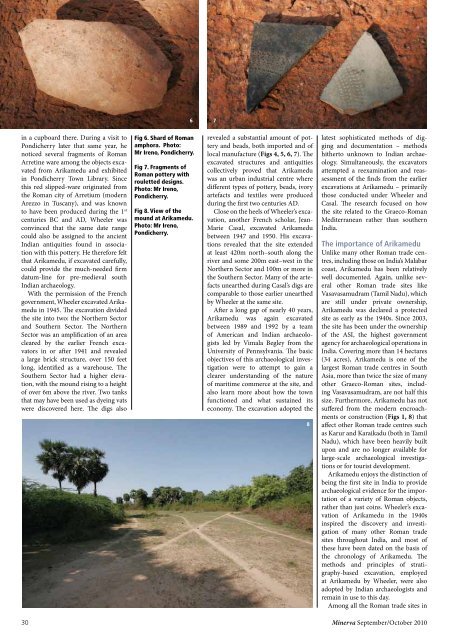Alexander in Amsterdam - Minerva
Alexander in Amsterdam - Minerva
Alexander in Amsterdam - Minerva
Create successful ePaper yourself
Turn your PDF publications into a flip-book with our unique Google optimized e-Paper software.
<strong>in</strong> a cupboard there. Dur<strong>in</strong>g a visit to<br />
Pondicherry later that same year, he<br />
noticed several fragments of Roman<br />
Arret<strong>in</strong>e ware among the objects excavated<br />
from Arikamedu and exhibited<br />
<strong>in</strong> Pondicherry Town Library. S<strong>in</strong>ce<br />
this red slipped-ware orig<strong>in</strong>ated from<br />
the Roman city of Arretium (modern<br />
Arezzo <strong>in</strong> Tuscany), and was known<br />
to have been produced dur<strong>in</strong>g the 1 st<br />
centuries BC and AD, Wheeler was<br />
conv<strong>in</strong>ced that the same date range<br />
could also be assigned to the ancient<br />
Indian antiquities found <strong>in</strong> association<br />
with this pottery. He therefore felt<br />
that Arikamedu, if excavated carefully,<br />
could provide the much-needed firm<br />
datum-l<strong>in</strong>e for pre-medieval south<br />
Indian archaeology.<br />
With the permission of the French<br />
government, Wheeler excavated Arikamedu<br />
<strong>in</strong> 1945. The excavation divided<br />
the site <strong>in</strong>to two: the Northern Sector<br />
and Southern Sector. The Northern<br />
Sector was an amplification of an area<br />
cleared by the earlier French excavators<br />
<strong>in</strong> or after 1941 and revealed<br />
a large brick structure, over 150 feet<br />
long, identified as a warehouse. The<br />
Southern Sector had a higher elevation,<br />
with the mound ris<strong>in</strong>g to a height<br />
of over 6m above the river. Two tanks<br />
that may have been used as dye<strong>in</strong>g vats<br />
were discovered here. The digs also<br />
30<br />
Fig 6. Shard of Roman<br />
amphora. Photo:<br />
Mr Ireno, Pondicherry.<br />
Fig 7. Fragments of<br />
Roman pottery with<br />
rouletted designs.<br />
Photo: Mr Ireno,<br />
Pondicherry.<br />
Fig 8. View of the<br />
mound at Arikamedu.<br />
Photo: Mr Ireno,<br />
Pondicherry.<br />
6 7<br />
revealed a substantial amount of pottery<br />
and beads, both imported and of<br />
local manufacture (Figs 4, 5, 6, 7). The<br />
excavated structures and antiquities<br />
collectively proved that Arikamedu<br />
was an urban <strong>in</strong>dustrial centre where<br />
different types of pottery, beads, ivory<br />
artefacts and textiles were produced<br />
dur<strong>in</strong>g the first two centuries AD.<br />
Close on the heels of Wheeler’s excavation,<br />
another French scholar, Jean-<br />
Marie Casal, excavated Arikamedu<br />
between 1947 and 1950. His excavations<br />
revealed that the site extended<br />
at least 420m north–south along the<br />
river and some 200m east–west <strong>in</strong> the<br />
Northern Sector and 100m or more <strong>in</strong><br />
the Southern Sector. Many of the artefacts<br />
unearthed dur<strong>in</strong>g Casal’s digs are<br />
comparable to those earlier unearthed<br />
by Wheeler at the same site.<br />
After a long gap of nearly 40 years,<br />
Arikamedu was aga<strong>in</strong> excavated<br />
between 1989 and 1992 by a team<br />
of American and Indian archaeologists<br />
led by Vimala Begley from the<br />
University of Pennsylvania. The basic<br />
objectives of this archaeological <strong>in</strong>vestigation<br />
were to attempt to ga<strong>in</strong> a<br />
clearer understand<strong>in</strong>g of the nature<br />
of maritime commerce at the site, and<br />
also learn more about how the town<br />
functioned and what susta<strong>in</strong>ed its<br />
economy. The excavation adopted the<br />
8<br />
latest sophisticated methods of digg<strong>in</strong>g<br />
and documentation – methods<br />
hitherto unknown to Indian archaeology.<br />
Simultaneously, the excavators<br />
attempted a reexam<strong>in</strong>ation and reassessment<br />
of the f<strong>in</strong>ds from the earlier<br />
excavations at Arikamedu – primarily<br />
those conducted under Wheeler and<br />
Casal. The research focused on how<br />
the site related to the Graeco-Roman<br />
Mediterranean rather than southern<br />
India.<br />
The importance of Arikamedu<br />
Unlike many other Roman trade centres,<br />
<strong>in</strong>clud<strong>in</strong>g those on India’s Malabar<br />
coast, Arikamedu has been relatively<br />
well documented. Aga<strong>in</strong>, unlike several<br />
other Roman trade sites like<br />
Vasavasamudram (Tamil Nadu), which<br />
are still under private ownership,<br />
Arikamedu was declared a protected<br />
site as early as the 1940s. S<strong>in</strong>ce 2003,<br />
the site has been under the ownership<br />
of the ASI, the highest government<br />
agency for archaeological operations <strong>in</strong><br />
India. Cover<strong>in</strong>g more than 14 hectares<br />
(34 acres), Arikamedu is one of the<br />
largest Roman trade centres <strong>in</strong> South<br />
Asia, more than twice the size of many<br />
other Graeco-Roman sites, <strong>in</strong>clud<strong>in</strong>g<br />
Vasavasamudram, are not half this<br />
size. Furthermore, Arikamedu has not<br />
suffered from the modern encroachments<br />
or construction (Figs 1, 8) that<br />
affect other Roman trade centres such<br />
as Karur and Karaikadu (both <strong>in</strong> Tamil<br />
Nadu), which have been heavily built<br />
upon and are no longer available for<br />
large-scale archaeological <strong>in</strong>vestigations<br />
or for tourist development.<br />
Arikamedu enjoys the dist<strong>in</strong>ction of<br />
be<strong>in</strong>g the first site <strong>in</strong> India to provide<br />
archaeological evidence for the importation<br />
of a variety of Roman objects,<br />
rather than just co<strong>in</strong>s. Wheeler’s excavation<br />
of Arikamedu <strong>in</strong> the 1940s<br />
<strong>in</strong>spired the discovery and <strong>in</strong>vestigation<br />
of many other Roman trade<br />
sites throughout India, and most of<br />
these have been dated on the basis of<br />
the chronology of Arikamedu. The<br />
methods and pr<strong>in</strong>ciples of stratigraphy-based<br />
excavation, employed<br />
at Arikamedu by Wheeler, were also<br />
adopted by Indian archaeologists and<br />
rema<strong>in</strong> <strong>in</strong> use to this day.<br />
Among all the Roman trade sites <strong>in</strong><br />
M<strong>in</strong>erva September/October 2010

















